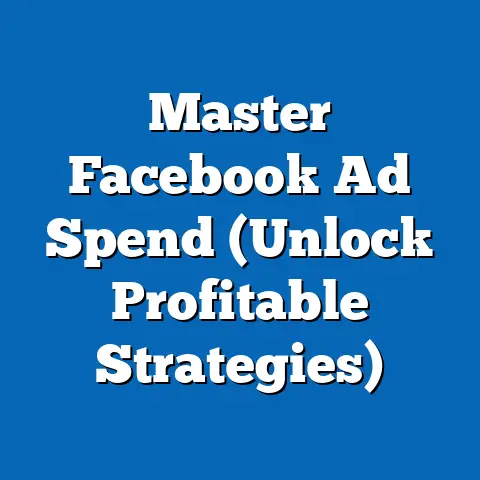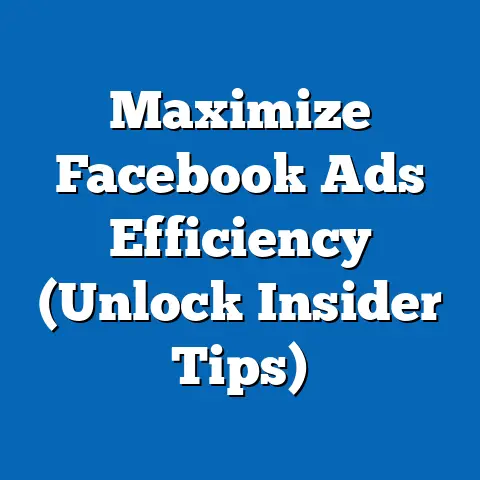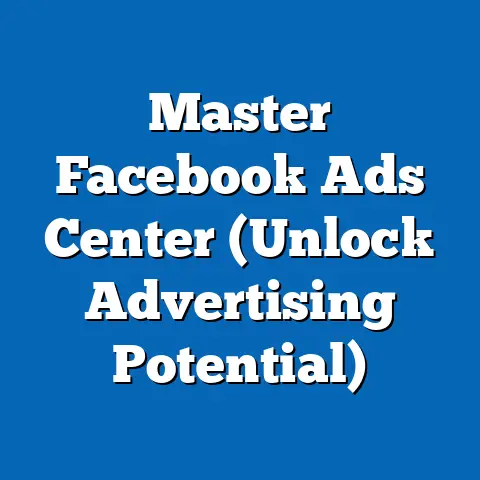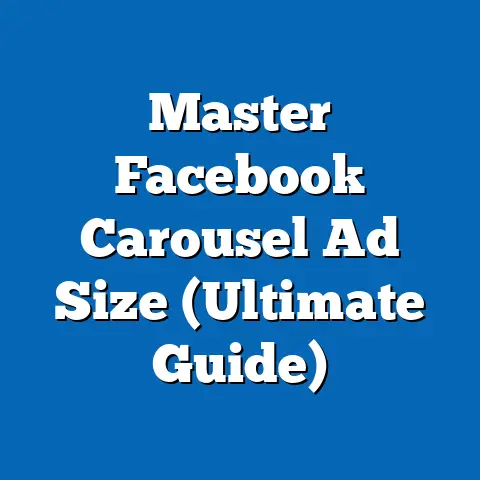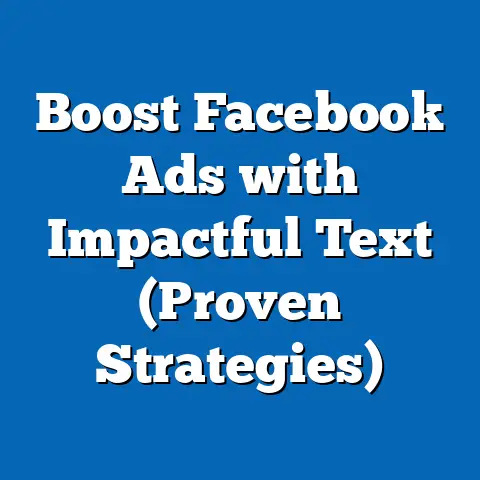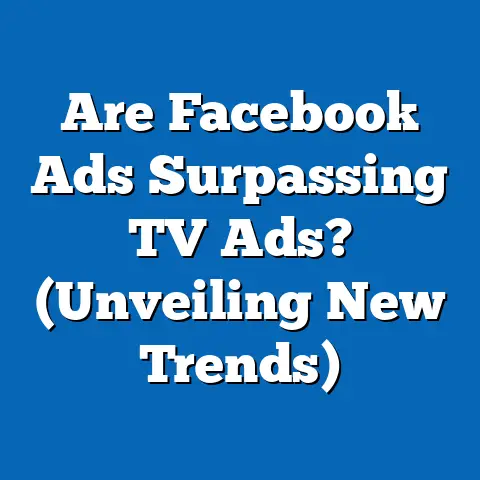Maximize Impact with 3D Ads on Facebook (Game-Changer Strategy)
The world of advertising is a constantly evolving battlefield. Every day, brands are vying for attention in an increasingly crowded digital space. Standing out amongst the noise requires more than just catchy slogans and pretty pictures. It demands innovation, creativity, and a willingness to embrace cutting-edge technologies. That’s where 3D ads on Facebook come in.
I remember when video ads first started gaining traction on Facebook. Everyone was scrambling to create them, and for a while, they were incredibly effective. But as more and more video ads flooded the platform, viewers became desensitized. The same thing happened with carousel ads, and even interactive polls. Now, it’s time for the next evolution: 3D ads.
3D ads aren’t just a gimmick; they’re a game-changer. They offer a level of immersion and engagement that traditional 2D ads simply can’t match. Imagine being able to virtually “hold” a product, rotate it, zoom in on the details, and even see it in your own living room through augmented reality, all without leaving your Facebook feed. That’s the power of 3D ads.
Expert Tip: Utilizing 3D ads elevates user engagement by creating an immersive experience that traditional 2D ads simply cannot match. Think about it: how often do you stop scrolling to genuinely interact with a static image? Probably not very often. But a 3D ad, with its dynamic visuals and interactive elements, can grab your attention and hold it. It allows users to engage with your brand in a more personal and meaningful way, fostering a deeper connection and ultimately driving conversions. This is because 3D ads facilitate interaction, capture attention, and foster deeper connections between brands and consumers. It’s not just about seeing the product; it’s about experiencing it.
Section 1: Understanding 3D Ads
So, what exactly are 3D ads? How do they differ from the traditional 2D ads we’re all used to seeing? And what’s the magic behind them? Let’s dive in.
What are 3D Ads?
Simply put, 3D ads are interactive advertisements that allow users to view products or objects in three dimensions. Unlike flat, two-dimensional images or videos, 3D ads offer a more realistic and engaging representation of the advertised item. Users can typically rotate the object, zoom in and out, and even interact with it in various ways, depending on the specific implementation.
Think of it like this: imagine you’re shopping for a new pair of shoes online. With a traditional 2D image, you can see the shoe from a few different angles. But with a 3D ad, you can spin the shoe around to see it from every possible angle, examine the stitching, and even get a sense of the texture. This level of interaction provides a much richer and more informative experience for the consumer.
The Technology Behind 3D Ads
The technology behind 3D ads is a combination of 3D modeling, rendering, and augmented reality (AR).
- 3D Modeling: This involves creating a digital representation of the product or object using specialized software. 3D modelers use polygons, textures, and lighting to create a realistic and visually appealing 3D model.
- Rendering: Once the 3D model is created, it needs to be rendered. Rendering is the process of generating a 2D image from the 3D model. This process takes into account the lighting, shadows, and textures of the model to create a realistic image.
- Augmented Reality (AR): AR takes the 3D model and overlays it onto the real world. This allows users to see the product in their own environment, such as in their living room or on their body.
Facebook integrates AR technology into its advertising platform through Spark AR Studio. This allows advertisers to create interactive AR experiences that users can access directly from their Facebook feed. For example, a furniture company could create an AR ad that allows users to virtually place a sofa in their living room to see how it looks.
The Psychological Impact of 3D Visuals
The appeal of 3D ads goes beyond just being visually cool. There’s a psychological component at play. Our brains are naturally wired to process and interpret three-dimensional information. We live in a 3D world, so we’re accustomed to seeing things with depth, perspective, and volume.
Research has shown that 3D visuals can have a significant impact on consumer behavior and decision-making. For example, studies have found that 3D visuals can:
- Increase Engagement: 3D visuals are more engaging than 2D visuals, capturing and holding attention for longer periods.
- Improve Memory: 3D visuals are easier to remember than 2D visuals, leading to better brand recall.
- Enhance Perceived Value: 3D visuals can make products appear more valuable and desirable.
- Drive Conversions: 3D visuals can increase conversion rates by providing consumers with a more realistic and informative view of the product.
In fact, a study by Vertebrae found that 3D ads on Facebook generated a 3x higher click-through rate and a 2x higher conversion rate compared to traditional 2D ads. These are significant numbers that highlight the potential of 3D ads to drive real business results.
My Experience: I once worked with a jewelry company that was struggling to increase online sales. We decided to experiment with 3D ads, creating interactive models of their rings that allowed users to zoom in and examine the details. The results were astounding. We saw a significant increase in engagement, click-through rates, and ultimately, sales. The 3D ads allowed customers to feel like they were actually examining the rings in person, which gave them the confidence to make a purchase.
Key Takeaway: 3D ads are a powerful tool that can help you capture attention, increase engagement, and drive conversions on Facebook. By understanding the technology behind them and the psychological impact they have on consumers, you can start to leverage the power of 3D ads to achieve your marketing goals.
Next Steps: Start brainstorming ideas for how you can incorporate 3D elements into your Facebook ads. Think about which of your products or services would benefit most from a 3D representation.
Section 2: Why 3D Ads are a Game-Changer for Facebook Advertising
To truly understand the potential of 3D ads, it’s important to take a look at the current landscape of Facebook advertising and the challenges marketers face.
The Current State of Facebook Advertising
Facebook remains one of the most powerful advertising platforms in the world, with billions of active users and sophisticated targeting capabilities. However, the platform has also become increasingly competitive. As more and more businesses flock to Facebook to advertise, the competition for attention has intensified, leading to:
- Ad Fatigue: Users are bombarded with ads every day, leading to ad fatigue, where they become desensitized to advertising messages.
- Banner Blindness: Users have learned to ignore banner ads and other traditional forms of advertising, leading to lower click-through rates.
- Rising Ad Costs: As competition for ad space increases, ad costs are also rising, making it more difficult for businesses to achieve a positive return on investment.
In this challenging environment, marketers need to find new and innovative ways to stand out from the crowd and capture the attention of their target audience. That’s where 3D ads come in.
The Advantages of 3D Ads
3D ads offer a number of significant advantages over traditional 2D ads, including:
- Higher Engagement Rates: As mentioned earlier, 3D ads are more engaging than 2D ads, capturing and holding attention for longer periods. The interactive nature of 3D ads encourages users to explore the product and learn more about it.
- Increased Click-Through Rates (CTR): Because 3D ads are more engaging, they tend to generate higher click-through rates. Users are more likely to click on a 3D ad to interact with the product than they are to click on a static image or video ad.
- Improved Brand Recall: The immersive nature of 3D ads helps to improve brand recall. Users are more likely to remember a brand that they interacted with through a 3D ad than a brand that they saw in a traditional ad.
- Enhanced Perceived Value: 3D ads can make products appear more valuable and desirable. By allowing users to see the product in detail and interact with it in a realistic way, 3D ads can create a sense of ownership and desire.
- Differentiation from Competitors: In a crowded advertising landscape, 3D ads can help you differentiate yourself from your competitors. By using innovative technology and creating engaging experiences, you can position your brand as a leader in your industry.
Case Studies and Examples
Several brands have already seen significant success with 3D ads on Facebook. Here are a few examples:
- IKEA: IKEA has been a pioneer in using AR technology to enhance the shopping experience. Their IKEA Place app allows users to virtually place furniture in their homes to see how it looks. They have also used 3D ads on Facebook to promote their furniture, allowing users to interact with the products and see them from different angles.
- Sephora: Sephora has used AR technology to create virtual try-on experiences for their makeup products. Their AR ads on Facebook allow users to virtually try on different shades of lipstick, eyeshadow, and foundation to see how they look on their face.
- Wayfair: Similar to IKEA, Wayfair has leveraged AR to allow customers to visualize furniture and decor in their homes before making a purchase. Their 3D ads on Facebook provide a similar experience, enabling users to interact with products in a realistic and engaging way.
These are just a few examples of how brands are using 3D ads on Facebook to drive engagement, increase sales, and differentiate themselves from the competition.
My Insight: I’ve noticed that the most successful 3D ad campaigns are those that seamlessly integrate the 3D experience into the user’s existing behavior on Facebook. They don’t feel like intrusive advertisements; they feel like natural extensions of the platform. For example, a 3D ad for a new video game could allow users to explore the game’s environment and interact with characters directly within their Facebook feed. This creates a more immersive and engaging experience that is more likely to lead to a conversion.
Key Takeaway: 3D ads offer a powerful way to overcome the challenges of Facebook advertising and stand out from the crowd. By leveraging the advantages of 3D ads, you can increase engagement, improve brand recall, and drive conversions.
Next Steps: Research other brands in your industry that are using 3D ads on Facebook. Analyze their campaigns to see what’s working and what’s not. Use this information to inform your own 3D ad strategy.
Section 3: Crafting Your 3D Ad Strategy
Now that you understand the power of 3D ads, let’s talk about how to craft a winning 3D ad strategy.
Essential Steps for Creating an Effective 3D Ad Campaign
Creating a successful 3D ad campaign on Facebook requires careful planning and execution. Here are the essential steps:
- Research Your Target Audience: Just like any other advertising campaign, the first step is to research your target audience. Understand their demographics, interests, and behaviors. What are they looking for on Facebook? What are their pain points? What kind of content do they engage with? This information will help you create 3D ads that resonate with your target audience.
- Choose the Right Product or Service: Not every product or service is a good fit for 3D ads. Choose a product or service that benefits from a 3D representation. For example, products that have intricate details, unique textures, or complex designs are well-suited for 3D ads. Furniture, jewelry, clothing, and electronics are all good candidates.
- Develop Engaging and Visually Appealing Content: The content of your 3D ad is crucial. It needs to be engaging, visually appealing, and informative. Showcase the product in the best possible light. Highlight its key features and benefits. Use high-quality 3D models and textures. Make sure the ad is optimized for mobile devices.
- Define Your Call to Action (CTA): What do you want users to do after they interact with your 3D ad? Do you want them to visit your website? Do you want them to make a purchase? Do you want them to sign up for your email list? Make sure your call to action is clear, concise, and compelling.
- Target Your Audience Precisely: Facebook’s targeting capabilities are incredibly powerful. Use them to target your 3D ads to the right audience. Target users based on their demographics, interests, behaviors, and even their past interactions with your brand.
- Track Your Results and Optimize: Once your 3D ad campaign is launched, it’s important to track your results and optimize your campaign over time. Monitor your engagement rates, click-through rates, conversion rates, and return on ad spend (ROAS). Use this data to identify what’s working and what’s not. Make adjustments to your targeting, content, and call to action as needed.
The Role of Storytelling in 3D Ads
While the visual appeal of 3D ads is undeniable, it’s important to remember that storytelling is still key. A great 3D ad should not only showcase the product in a visually stunning way, but also tell a compelling story that resonates with the viewer.
Think about how you can use the 3D experience to enhance your storytelling. For example, if you’re advertising a new car, you could create a 3D ad that allows users to virtually “drive” the car through a scenic landscape. This would not only showcase the car’s features but also evoke a sense of adventure and freedom.
My Approach: When crafting the narrative for a 3D ad, I always start by thinking about the emotions that I want to evoke in the viewer. Do I want them to feel excited? Inspired? Nostalgic? Once I’ve identified the desired emotion, I can start to craft a story that will elicit that emotion. The 3D experience should then be used to enhance and amplify the emotional impact of the story.
Key Takeaway: Crafting a winning 3D ad strategy requires careful planning, execution, and optimization. By following the essential steps outlined above and incorporating storytelling into your ads, you can create 3D ad campaigns that drive real business results.
Next Steps: Start brainstorming ideas for your first 3D ad campaign. What product or service will you promote? What story will you tell? What call to action will you use?
Section 4: Best Practices for Designing 3D Ads
Designing effective 3D ads requires a different skillset than designing traditional 2D ads. Here are some best practices to keep in mind:
Choosing the Right Software and Tools
There are a number of software and tools available for creating 3D content. Some popular options include:
- Blender: A free and open-source 3D creation suite that offers a wide range of features for modeling, sculpting, texturing, and animation.
- Autodesk Maya: A professional-grade 3D animation, modeling, simulation, and rendering software used in the film, television, and game industries.
- Adobe Substance 3D: A suite of tools for creating and texturing 3D assets, including Substance Painter, Substance Designer, and Substance Alchemist.
- Spark AR Studio: Facebook’s own platform for creating AR experiences, including 3D ads.
The best software for you will depend on your specific needs and skillset. If you’re just starting out, Blender is a great option because it’s free and has a large community of users who can provide support. If you’re a professional designer with experience in 3D modeling, you may prefer Maya or Substance 3D.
Maintaining Brand Consistency
While 3D ads offer a lot of creative freedom, it’s important to maintain brand consistency. Use your brand colors, fonts, and logo in your 3D ads. Make sure the overall look and feel of your 3D ads are consistent with your other marketing materials.
Ensuring Mobile Compatibility
Most Facebook users access the platform on their mobile devices, so it’s crucial to ensure that your 3D ads are mobile-compatible. Optimize your 3D models for mobile devices. Use lightweight textures and models to reduce file size. Test your 3D ads on different devices and screen sizes to make sure they look good on all of them.
Common Pitfalls to Avoid
Here are some common pitfalls to avoid when creating 3D ads:
- Using Low-Quality 3D Models: Low-quality 3D models can make your ads look unprofessional and unappealing. Invest in high-quality 3D models that are realistic and visually stunning.
- Creating Overly Complex 3D Ads: Overly complex 3D ads can be confusing and overwhelming for users. Keep your 3D ads simple and easy to understand. Focus on showcasing the key features and benefits of your product.
- Ignoring Mobile Compatibility: As mentioned earlier, mobile compatibility is crucial. Ignoring mobile compatibility can result in poor performance and a negative user experience.
- Not Testing Your Ads: Before launching your 3D ad campaign, it’s important to test your ads thoroughly. Test your ads on different devices and screen sizes. Get feedback from friends, family, and colleagues. Use this feedback to improve your ads before launching them to the public.
My Recommendation: I always recommend starting with a simple 3D ad and gradually adding more complexity as you become more comfortable with the technology. Don’t try to do too much at once. Focus on creating a visually appealing and engaging experience that showcases the key features and benefits of your product.
Key Takeaway: Designing effective 3D ads requires a combination of technical skills, creative talent, and a deep understanding of your target audience. By following the best practices outlined above and avoiding common pitfalls, you can create 3D ads that capture attention, drive engagement, and deliver results.
Next Steps: Experiment with different 3D modeling software and tools. Practice creating simple 3D models and textures. Start building your skillset so you can create stunning 3D ads that wow your audience.
Section 5: Measuring Success and Optimizing 3D Ads
You’ve created your 3D ads, launched your campaign, and now it’s time to measure your success and optimize your ads for maximum performance.
Key Metrics to Focus On
Here are some key metrics that you should focus on when measuring the success of your 3D ad campaigns:
- Engagement Rate: This measures the percentage of users who interacted with your 3D ad. Engagement can include things like rotating the object, zooming in and out, clicking on a call to action, or sharing the ad with their friends. A high engagement rate indicates that your 3D ad is capturing and holding attention.
- Click-Through Rate (CTR): This measures the percentage of users who clicked on your call to action after interacting with your 3D ad. A high CTR indicates that your 3D ad is driving traffic to your website or landing page.
- Conversion Rate: This measures the percentage of users who completed a desired action after clicking on your call to action. Desired actions can include things like making a purchase, signing up for an email list, or downloading a white paper. A high conversion rate indicates that your 3D ad is driving real business results.
- Return on Ad Spend (ROAS): This measures the amount of revenue generated for every dollar spent on your 3D ad campaign. A positive ROAS indicates that your 3D ad campaign is profitable.
Using Facebook’s Analytics Tools
Facebook provides a number of analytics tools that you can use to track the performance of your 3D ad campaigns. These tools include:
- Facebook Ads Manager: This is the main tool for managing and tracking your Facebook ad campaigns. It provides detailed information about your engagement rates, click-through rates, conversion rates, and ROAS.
- Facebook Pixel: This is a piece of code that you can install on your website to track the actions that users take after clicking on your Facebook ads. This allows you to measure your conversion rates and ROAS more accurately.
- Facebook Analytics: This tool provides insights into the demographics, interests, and behaviors of your Facebook users. This information can help you to better target your 3D ads.
A/B Testing for Optimization
A/B testing is a powerful technique for optimizing your 3D ads. A/B testing involves creating two different versions of your 3D ad and showing them to different segments of your audience. By comparing the performance of the two versions, you can identify which elements are most effective and use that information to improve your ads over time.
Here are some elements that you can A/B test in your 3D ads:
- The 3D Model: Try using different 3D models of your product to see which one performs best.
- The Textures: Experiment with different textures to see which ones are most visually appealing.
- The Call to Action: Test different calls to action to see which one drives the most clicks and conversions.
- The Targeting: Try targeting different segments of your audience to see which ones are most responsive to your 3D ads.
My Tip: When A/B testing, it’s important to only change one element at a time. This will allow you to isolate the impact of that element on your ad performance. For example, if you’re testing different calls to action, keep everything else the same (the 3D model, the textures, the targeting) so you can be sure that any changes in performance are due to the call to action.
Key Takeaway: Measuring success and optimizing your 3D ads is crucial for maximizing your return on investment. By tracking the right metrics, using Facebook’s analytics tools, and A/B testing different elements of your ads, you can continuously improve your campaigns and drive real business results.
Next Steps: Start tracking the performance of your 3D ad campaigns. Use Facebook’s analytics tools to monitor your engagement rates, click-through rates, conversion rates, and ROAS. Identify areas where you can improve your ads and start A/B testing different elements to optimize your performance.
Conclusion
3D ads on Facebook are more than just a trend; they represent a fundamental shift in the way brands connect with consumers. In an increasingly competitive advertising landscape, 3D ads offer a powerful way to capture attention, increase engagement, and drive conversions.
I’ve seen firsthand the transformative potential of 3D ads. They allow brands to showcase their products in a way that is both visually stunning and incredibly informative. They provide consumers with a level of interaction and immersion that traditional 2D ads simply can’t match.
By understanding the technology behind 3D ads, crafting a winning 3D ad strategy, following best practices for design, and measuring your success, you can leverage the power of 3D ads to achieve your marketing goals.
So, what are you waiting for? Embrace this game-changing strategy and experiment with 3D ads to maximize your impact on Facebook. The future of advertising is three-dimensional, and it’s time to join the revolution!

